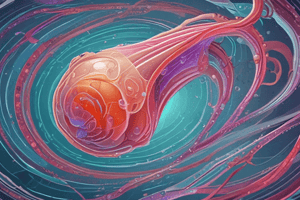Podcast
Questions and Answers
What is the primary function of the muscles surrounding the reproductive organs during sexual activity?
What is the primary function of the muscles surrounding the reproductive organs during sexual activity?
- To store sperm
- To produce sperm
- To transport sperm through the duct system (correct)
- To regulate hormone levels
What is the maximum number of sperm that can be present in each ejaculation?
What is the maximum number of sperm that can be present in each ejaculation?
- 1 billion
- 500 million (correct)
- 200 million
- 100 million
Which hormone plays a crucial role in stimulating sperm production?
Which hormone plays a crucial role in stimulating sperm production?
- Testosterone
- Follicle-stimulating hormone (FSH)
- Human chorionic gonadotropin (hCG)
- All of the above (correct)
Where does sperm production occur in the male reproductive system?
Where does sperm production occur in the male reproductive system?
What is the term for the process by which sperm are produced?
What is the term for the process by which sperm are produced?
Where do sperm cells complete their development and mature?
Where do sperm cells complete their development and mature?
Where does sperm production occur in the male reproductive system?
Where does sperm production occur in the male reproductive system?
What is the result of the transformation of round cells in the seminiferous tubules during puberty?
What is the result of the transformation of round cells in the seminiferous tubules during puberty?
What is the condition in which hormonal treatments may be used to stimulate sperm production?
What is the condition in which hormonal treatments may be used to stimulate sperm production?
What is the role of testosterone in sperm production?
What is the role of testosterone in sperm production?
What forms when sperm are mixed with seminal fluid during sexual stimulation?
What forms when sperm are mixed with seminal fluid during sexual stimulation?
What is the function of the vas deferens in the male reproductive system?
What is the function of the vas deferens in the male reproductive system?
Flashcards are hidden until you start studying
Study Notes
Sperm Production in the Male Reproductive System
Seminiferous Tubules and Spermatogenesis
In males, sperm production occurs in the testicles, which are part of the endocrine system because they produce hormones such as testosterone. The testes contain coiled masses of tubes called seminiferous tubules, where immature male germ cells divide, undergo meiosis, and differentiate into highly specialized haploid cells known as sperm cells.
Testosterone and Spermatogenesis
Testosterone is crucial for initiating sperm production. It stimulates the transformation of round cells in the seminiferous tubules into sperm cells during puberty. As testosterone levels increase, sperm cells develop to resemble tadpoles with a head and short tail, containing genetic material.
Completion of Sperm Development
After leaving the seminiferous tubules, sperm cells enter the epididymis, a long, coiled tube behind each testicle. Here, they complete their development and mature, becoming capable of fertilizing an egg.
Movement to Vas Deferens
Once mature, the sperm move to the vas deferens, a long, muscular tube that transports the sperm to the pelvic cavity.
Mixing with Seminal Fluid
When a male is sexually stimulated, the sperm are mixed with seminal fluid, a whitish liquid produced by the seminal vesicles and the prostate gland. This mixture forms semen.
Ejaculation and Semen Transport
During sexual activity, the muscles surrounding the reproductive organs contract, forcing the semen through the duct system and the urethra. Each ejaculation can contain up to 500 million sperm.
Factors Influencing Sperm Production
Spermatogenesis, the process by which sperm are produced, is influenced by hormones such as testosterone and follicle-stimulating hormone (FSH). Low levels of these hormones or other issues can impact sperm production and lead to fertility issues.
Role of FSH and hCG in Sperm Production
In some cases, men with reduced sperm counts may benefit from hormonal treatments to stimulate sperm production. For example, gonadotropic stimulation using human chorionic gonadotropin (hCG) and FSH can help induce spermatogenesis in men with hypogonadotropic hypogonadism or androgen deficiency.
In conclusion, the male reproductive system is designed to produce, store, and transport sperm for the process of reproduction. Sperm production occurs in the testicles through a series of processes involving hormones and specialized structures, ultimately leading to the formation of semen and its release during ejaculation.
Studying That Suits You
Use AI to generate personalized quizzes and flashcards to suit your learning preferences.




